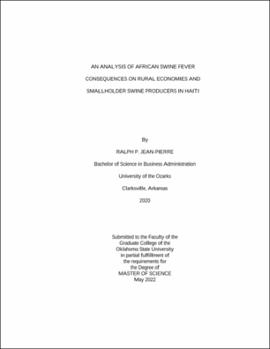| dc.contributor.advisor | Hagerman, Amy D. | |
| dc.contributor.author | Jean-Pierre, Ralph P. | |
| dc.date.accessioned | 2023-03-21T21:03:43Z | |
| dc.date.available | 2023-03-21T21:03:43Z | |
| dc.date.issued | 2022-05 | |
| dc.identifier.uri | https://hdl.handle.net/11244/337143 | |
| dc.description.abstract | African Swine Fever (ASF) causes high mortality, and often results in strict culling policies for affected pigs and international market restrictions. It took more than 25 years for swine inventories in Haiti and the Dominican Republic to recover from an ASF outbreak in 1978-1984. The 2021 outbreaks in the Dominican Republic and Haiti pose threats to animal health, livestock markets, and producer livelihoods. | |
| dc.description.abstract | A partial equilibrium Haitian pig sector model (HPM-2021) was developed to assess the economic impacts of a 2021 Haitian ASF outbreak of a similar size to the 1980s outbreak. The dynamic model examines ASF impacts from 2021 to 2024, through 100 iterations of stochastic supply shocks, and three specific demand shocks. Recovery alternatives are assessed through 2030. | |
| dc.description.abstract | Outbreaks and recovery outcomes are compared to a baseline reflecting 2019 trends. Findings demonstrate higher vulnerabilities of the traditional sector to ASF-related disruptions. The inflated prices generated by pork production shortfalls are an opportunity to accelerate income growth for remaining traditional pig producers. ASF supply-only shocks contribute to a minimum of 49% increase in traditional producer income, and a minimum of 2.22% growth in commercial producer income from the 2019 base year. Nevertheless, the potential for consumer avoidance of pork offset those gains by as much as 90% in the traditional sector and 44% in the commercial sector. Smaller commercial sector impacts derive from different elasticities. The analysis includes economic effects on national pork and maize in Haiti, the Dominican Republic, the rest of the Caribbean, and the rest of the world. | |
| dc.description.abstract | ASF-induced high prices also lead to increased consumer expenditures losses by up to 200%. Nevertheless, consumers’ expenditures tend to recover instantaneously with ASF eradication. Due to persisting demand shocks, producers will earn up to 0.3% lower than baseline levels income from 2027. | |
| dc.description.abstract | There are few models that evaluate economic impacts of health response policies in less developed countries like Haiti. HPM-2021 results highlight ASF impacts on prices, which can benefit certain producers and disincentivize on-farm disease reporting. Slow recovery and consumers’ avoidance of pork is detrimental to long-term swine industry survival, producer livelihoods, and the overall rural economy. | |
| dc.format | application/pdf | |
| dc.language | en_US | |
| dc.rights | Copyright is held by the author who has granted the Oklahoma State University Library the non-exclusive right to share this material in its institutional repository. Contact Digital Library Services at lib-dls@okstate.edu or 405-744-9161 for the permission policy on the use, reproduction or distribution of this material. | |
| dc.title | Analysis of African Swine Fever consequences on rural economies and smallholder swine producers in Haiti | |
| dc.contributor.committeeMember | DeVuyst, Eric | |
| dc.contributor.committeeMember | Raper, Kellie | |
| osu.filename | JeanPierre_okstate_0664M_17602.pdf | |
| osu.accesstype | Open Access | |
| dc.type.genre | Thesis | |
| dc.type.material | Text | |
| dc.subject.keywords | African Swine Fever | |
| dc.subject.keywords | economic impacts | |
| dc.subject.keywords | Haiti | |
| dc.subject.keywords | Partial Equilibrium Model | |
| thesis.degree.discipline | Agricultural Economics | |
| thesis.degree.grantor | Oklahoma State University | |
